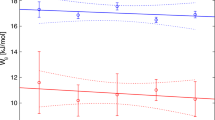Abstract
A rapid and simple test to distinguish halloysite from kaolinite in mineral mixtures has been developed based on differences in the rate and extent of formamide intercalation. With halloysite, complex formation was both rapid (<1 hr) and complete, whereas no significant intercalation occurred with kaolinite until at least 4 hr after contact with formamide, and then the process may not have been complete. Unheated halloysite formed complete complexes with formamide regardless of the interlayer hydration state of the mineral. The test, however, was inconclusive for halloysite that had been oven-dried at 110°C, although some water may still have been present in the interlayer space. The extent of formamide intercalation by kaolinite was likely influenced by sample crystallinity, and the rate of complex formation was enhanced by the addition of up to 10% v/v water to the system. Nevertheless, the formamide test unambiguously differentiated halloysite from kaolinite. N-methylformamide, which yields complexes with a basal spacing of 10.9 Å, could be substituted for formamide (basal spacing = 10.4 Å) for samples containing appreciable amounts of illitemica.
Резюме
Разработан быстрый и простой опыт для отличения галлуазита от каолинита в смесях минералов на основе разниц в скоростях и размере прослойки формамида. В случае галлуазита формирование комплексов было и быстрое (<1 часа) и полное, тогда как в случае каолинита значительная прослойка не появлялась по крайней мере 4 часа после контакта с формамидом и еще потом процесс мог быть не завершенным. Неподогретый галлуазит образовывал завершенные комплексы с формамидом несмотря на межслойное гидрационное состояние минерала. Однако нельзя было сделать выводы из опыта с галлуазитом, сушенным в печи при 110°С, хотя некоторые количество воды могло присутствовать в межслойном пространстве. На размер прослойки формамида с каолинитом, вероятно, влияла кристалличность образцов, а скорость образования комплекса увеличивалась при добавлении к системе до 10% воды (по объему). Тем не менее опыт с формамидом без сомнения отличал галлуазит от каолинита. N-метилформамид, который дает комплексы с основным расстоянием 10,9 Å мог бы быть заменен формамидом (основное расстояние = 10,4 Å) в случае образцов, содержащих значительные количества иллита-слюды. [E.G.]
Resümee
Es wurde ein schneller und einfacher Test zur Unterscheidung von Halloysit und Kaolinit in Mineralgemengen entwickelt, die auf der unterschiedlichen Geschwindigkeit und dem unterschiedlichen Ausmaß des Einbaus von Formamid beruht. Bei Halloysit geht die Komplexbildung sowohl schnell (< 1 Stunde) als auch vollständig vor sich, während bei Kaolinit bis mindestens 4 Stunden nach dem Beginn der Einwirkung von Formamid kein bemerkenswerter Einbau geschieht, und auch dann ist der Prozess nicht vollständig. Nicht erhitzter Halloysit bildet vollständige Komplexe mit Formamid unabhängig vom Hydratationsstadium der Zwischenschicht. Der Test war jedoch für Halloysit, der bei 110°C im Trockenschrank getrocknet wurde, nicht eindeutig, obwohl noch eine gewisse Menge Wasser in der Zwischenschicht enthalten gewesen Scin könnte. Das Ausmaß des Formamideinbaus durch Kaolinit wurde wahrscheinlich durch die Kristallinität der Probe beeinflußt, und die Geschwindigkeit der Komplexbildung wurde durch die Zugabe von bis zu 10% v/v Wasser zum System erhöht. Dennoch kann man durch den Formamid test eindeutig Halloysit von Kaolinit unterscheiden. N-methylformamid, mit dem Komplexe mit einem basalem Schichtabstand von 10,9 Å gebildet werden, kann anstelle von Formamid (Basis abstand 10,4 Å) bei Proben mit größeren Mengen Illit-Mica verwendet werden. [U.W.]
Résumé
Un test rapide et simple a été développé pour distinguer l’halloysite de la kaolinite dans des mélanges minéraux, basé sur les différences d’allure et d’étendue d’intercalation de formamide. Avec l’halloysite, la formation de complexe était à la fois rapide (< 1 heure) et complète, tandis qu’aucune intercalation significative ne s’est produite avec la kaolinite jusqu’à au moins 4 heures après le contact avec la formamide, et alors il est possible que le procédé n’ait pas été complet. L’halloysite non-chauffée a formé des complexes avec la formamide sans égards à l’état d’hydration interfeuillet du minéral. Aucune conclusion n’a cependant pû être tirée du test pour l’halloysite qui avait été sechée au four à 110°C, quoiqu’il est possible que de l’eau ait encore été présente dans l’espace interfeuillet. L’étendue de l’inter-calation de formamide par la kaolinite était probablement influencée par la cristallinité de l’échantillon, et l’allure de la formation du complexe a été encouragée par l’addition au système de jusqu’a 10% v/v d’eau. Il n’empêche que le test de formamide a differencié sans ambiguités l’halloysite de la kaolinite. La formamide N-méthyle, qui produit des complexes avec un espacement de base de 10,9 Å, pourrait être substituée à la formamide (espacement de base = 10,4 Å) pour des échantillons contenant des quantités appréciables d’illite/mica. [D.J.]
Similar content being viewed by others
References
Beutelspacher, H. and Van der Marel, H. W. (1968) Atlas of Electron Microscopy of Clay Minerals and Their Admixtures: Elsevier, Amsterdam, 333 pp.
Brindley, G. W. and de Souza Santos, P. (1966) New varieties of kaolin-group minerals and the problem of finding a suitable nomenclature: Proc. Int. Clay Conf., Jerusalem 1966, vol. 1, L. Heller and A. Weiss, eds., Israel Program for Scientific Translations, Jerusalem, 3–9.
Churchman, G. J. (1970) Interlayer water in halloysite: Ph.D. thesis, University of Otago, New Zealand, 258 pp.
Churchman, G. J. and Carr, R. M. (1975) The definition and nomenclature of halloysites: Clays & Clay Minerals 20, 241–246.
Churchman, G. J. and Theng, B. K. G. (1984) Interactions of halloysites with amides: mineralogical factors affecting complex formation: Clay Miner. 19, (in press).
Dixon, J.B. (1977) Kaolinite and serpentine group minerals: in Minerals in Soil Environments, J. B. Dixon and S. B. Weed, eds., Soil Science Society of America, Madison, Wisconsin, 357–403.
Hewitt, A. E. and Churchman, G. J. (1982) Formation, chemistry and mineralogy of soils from weathered schist, Eastern Otago, New Zealand: New Zealand J. Sci. 25, 253–269.
Hinckley, D. N. (1963) Variability in ‘crystallinity’ values among the kaolin deposits of the coastal plain of Georgia and South Carolina: in Clays & Clay Minerals, Proc. 11th Natl. Conf, Ottawa, Ontario, 1962, W. F. Bradley, ed., Pergamon Press, New York, 229–235.
Hughes, I.R. (1966) Mineral changes of halloysite on drying: New Zealand J. Sci. 9, 103–113.
Hughes, I. R. and Foster, P. K. (1970) The ranking of halloysites and kaolinites by moisture content measurements: New Zealand J. Sci. 13, 89–107.
Hughes, J. C. and Brown, G. (1979) A crystallinity index for soil kaolins and its relation to parent rock, climate and soil maturity: J. Soil Sci. 30, 557–563.
Jackson, M. L. (1956) Soil Chemical Analysis—Advanced Course: Published by the author, Dept. Soil Science, Univ. Wisconsin, Madison, Wisconsin, 991 pp.
Keller, W. D., Cheng, Hsia, Johns, W. D., and Meng, Chi-Sheng (1980) Kaolin from the original Kauling (Gaoling) mine locality, Kiangsi Province, China: Clays & Clay Minerals 28, 97–104.
Kirkman, J. H. (1981) Morphology and structure of halloysite in New Zealand tephras: Clays & Clay Minerals 29, 1–9.
Marsters, S. (1978) Report upon the extraction and industrial uses of halloysite: in Proc. Ann. Conf. Australasian Institute of Mining and Metallurgy, Whangarei, New Zealand 1978, Australasian Institute of Mining and Metallurgy, New Zealand Branch, Whangarei, 91–100.
Olejnik, S., Posner, A. M., and Quirk, J. P. (1970) The intercalation of polar organic compounds into kaolinite: Clay Miner. 8, 421–434.
Parker, T. W. (1969) A classification of kaolinites by infrared spectroscopy: Clay Miner. 8, 135–141.
Soil Survey Staff (1975) Soil Taxonomy: A Basic System of Soil Classification for Making and Interpreting Soil Surveys: U.S. Dept. Agriculture, Handbook No. 436, U.S. Govt. Printing Office, Washington, D.C., 754 pp.
Sudo, T., Shimoda, S., Yotsumoto, H., and Aita, S. (1981) Electron Micrographs of Clay Minerals: Kodansha, Tokyo and Elsevier, Amsterdam, 203 pp.
Theng, B. K. G., Churchman, G. J., Whitton, J. S., and Claridge, G. G. C. (1984) Comparison of intercalation methods for differentiating halloysite from kaolinite. Clays & Clay Minerals.
Wada, K. (1961) Lattice expansion of kaolin minerals by treatment with potassium acetate: Amer. Mineral. 46, 78–91.
Author information
Authors and Affiliations
Rights and permissions
About this article
Cite this article
Churchman, G.J., Whitton, J.S., Claridge, G.G.C. et al. Intercalation Method using Formamide for Differentiating Halloysite from Kaolinite. Clays Clay Miner. 32, 241–248 (1984). https://doi.org/10.1346/CCMN.1984.0320401
Received:
Accepted:
Published:
Issue Date:
DOI: https://doi.org/10.1346/CCMN.1984.0320401




